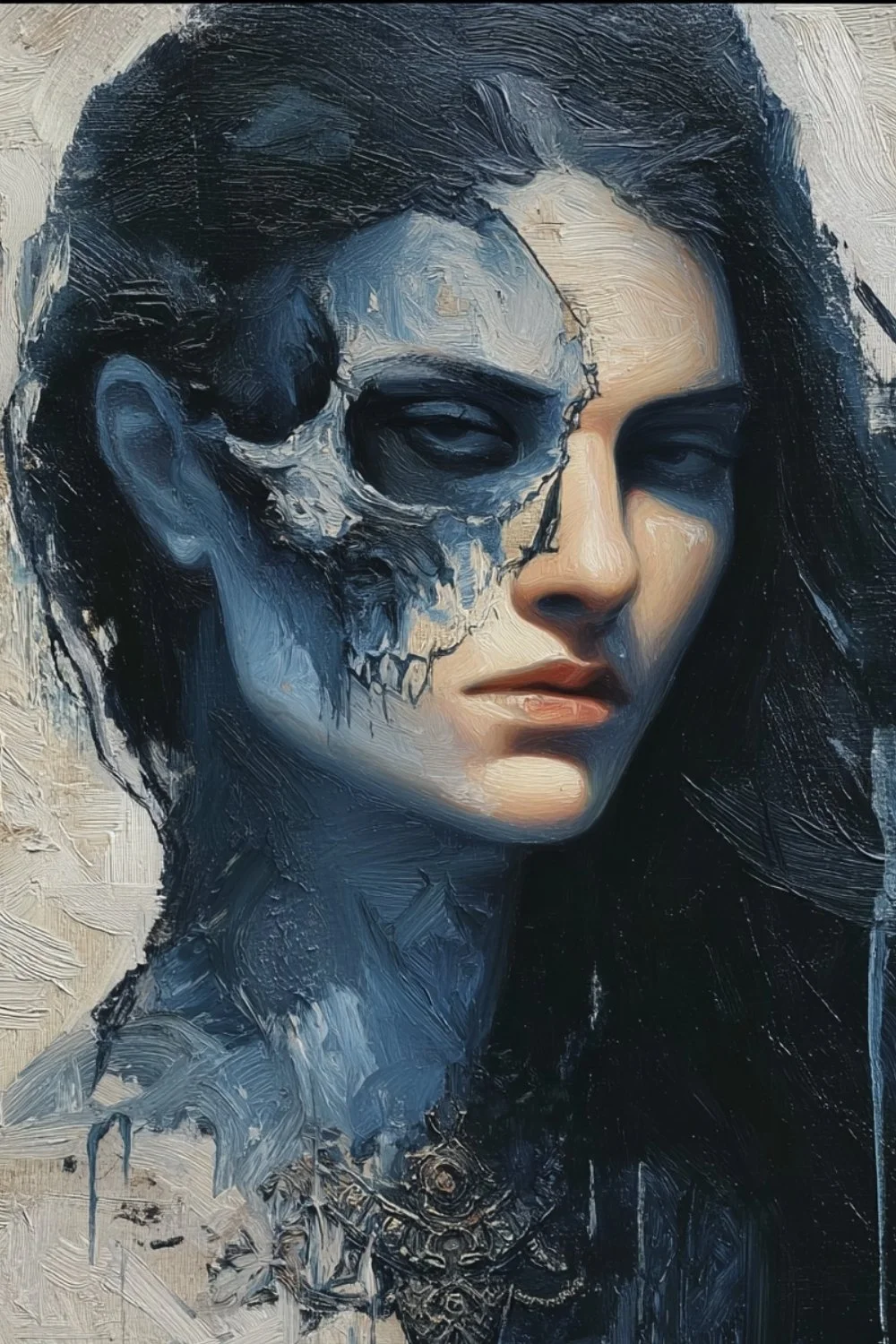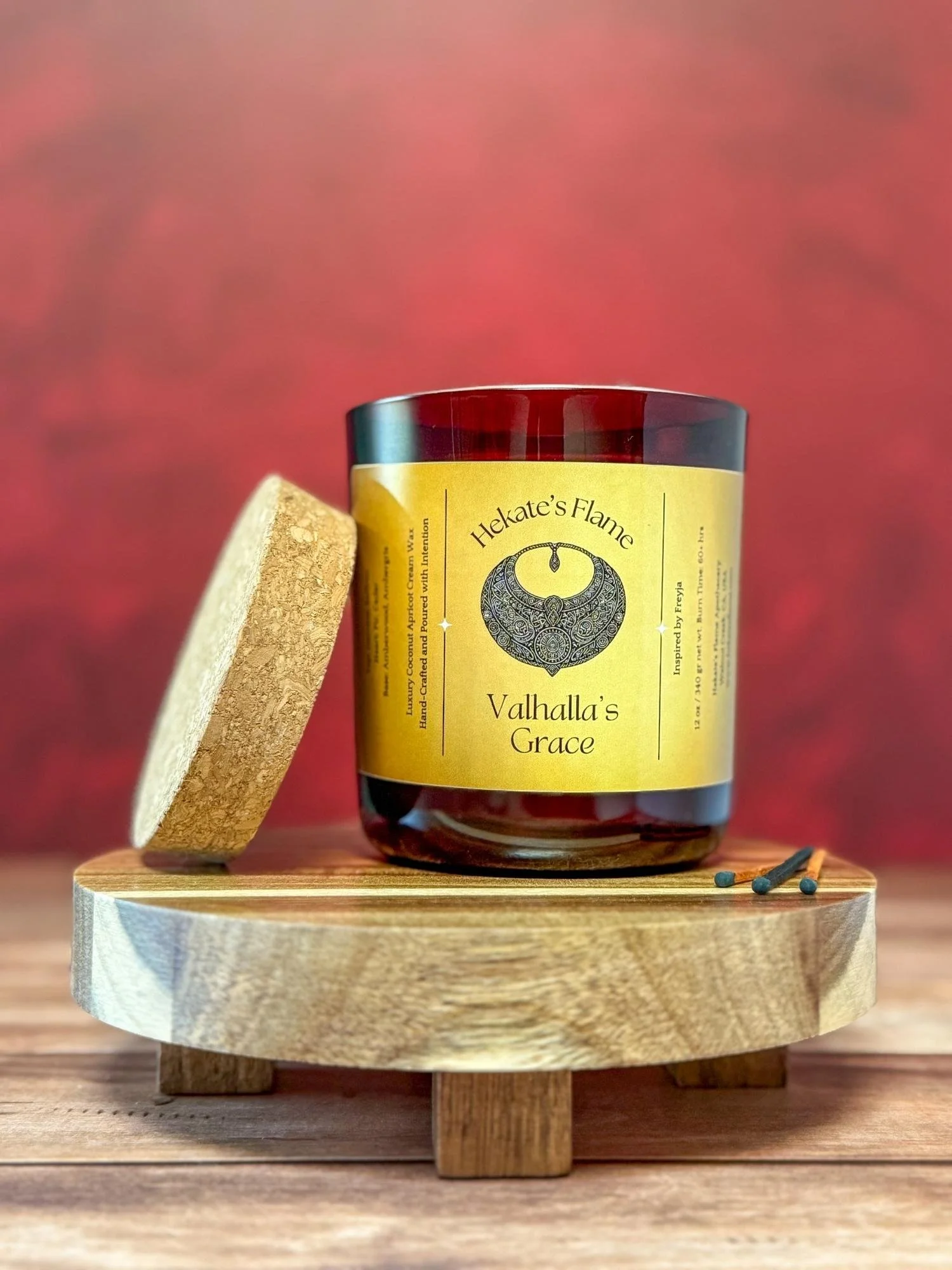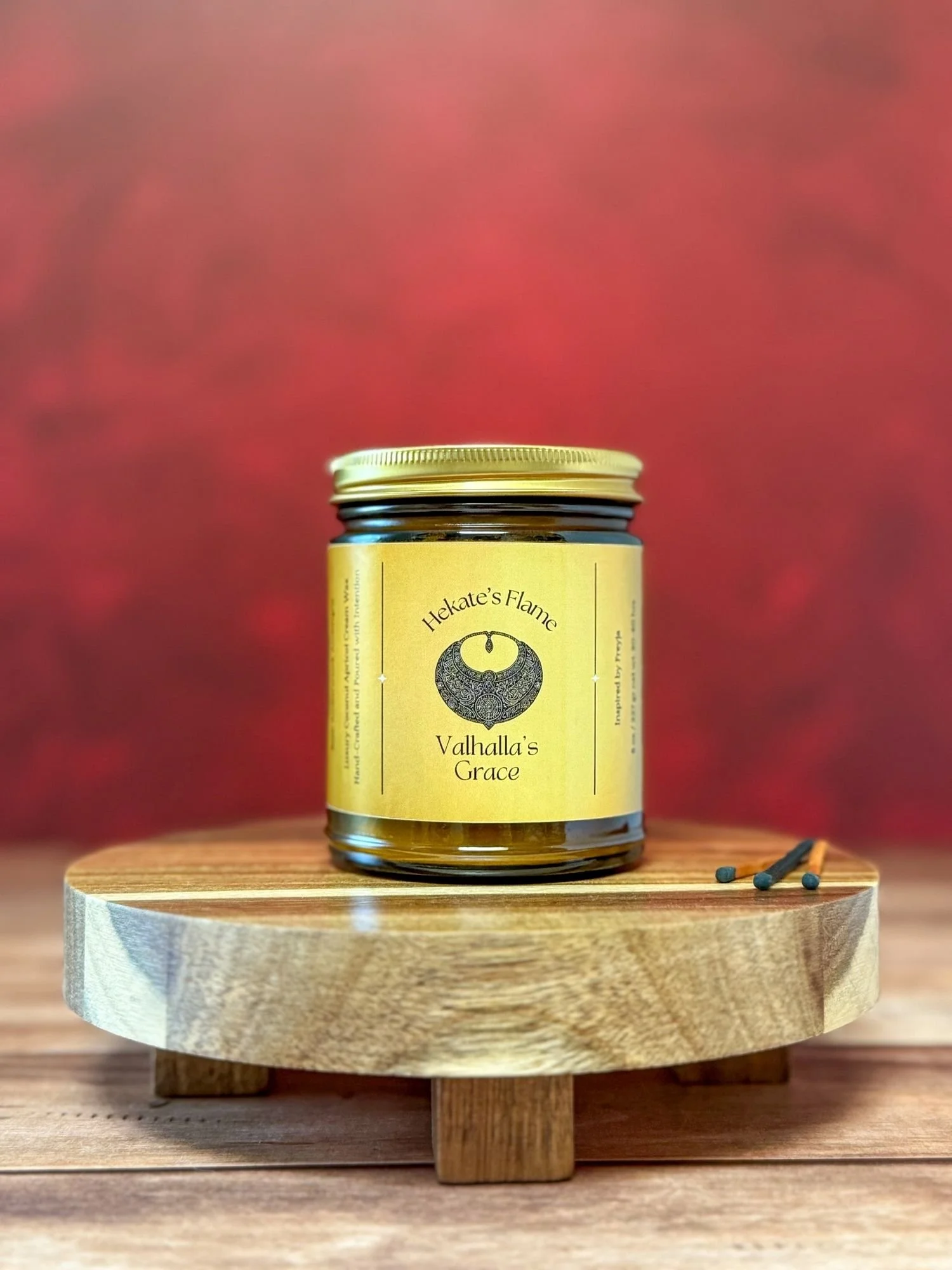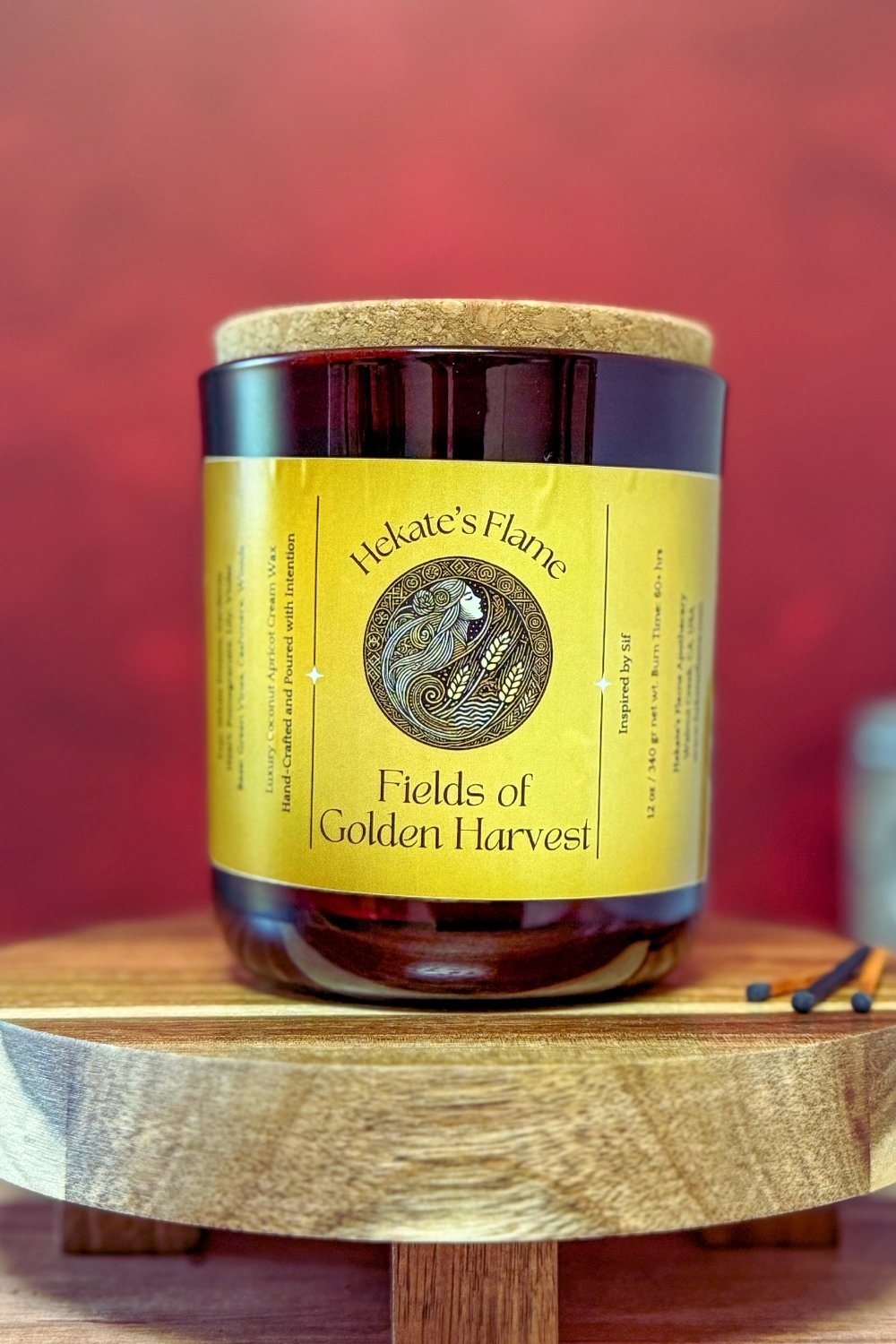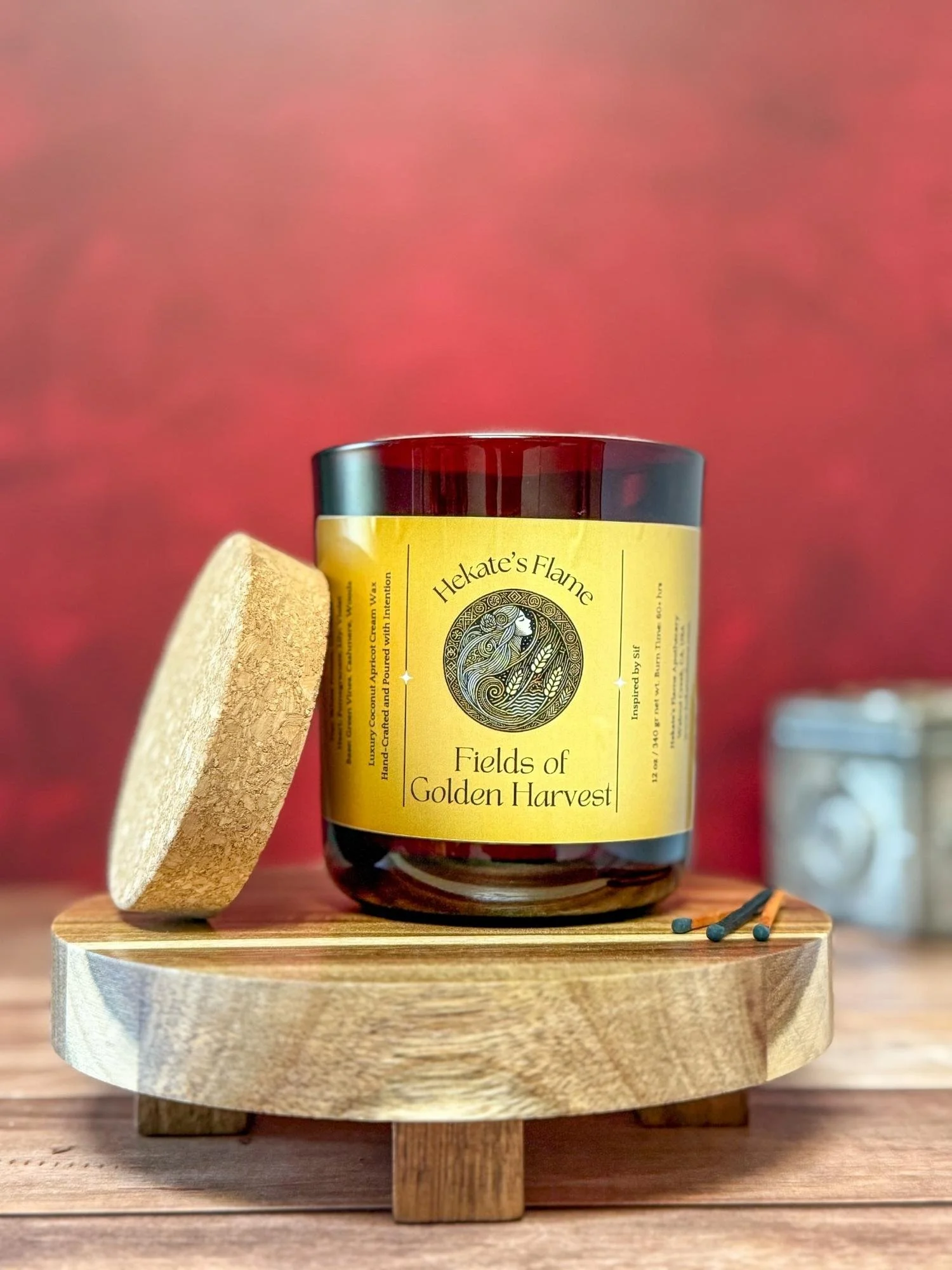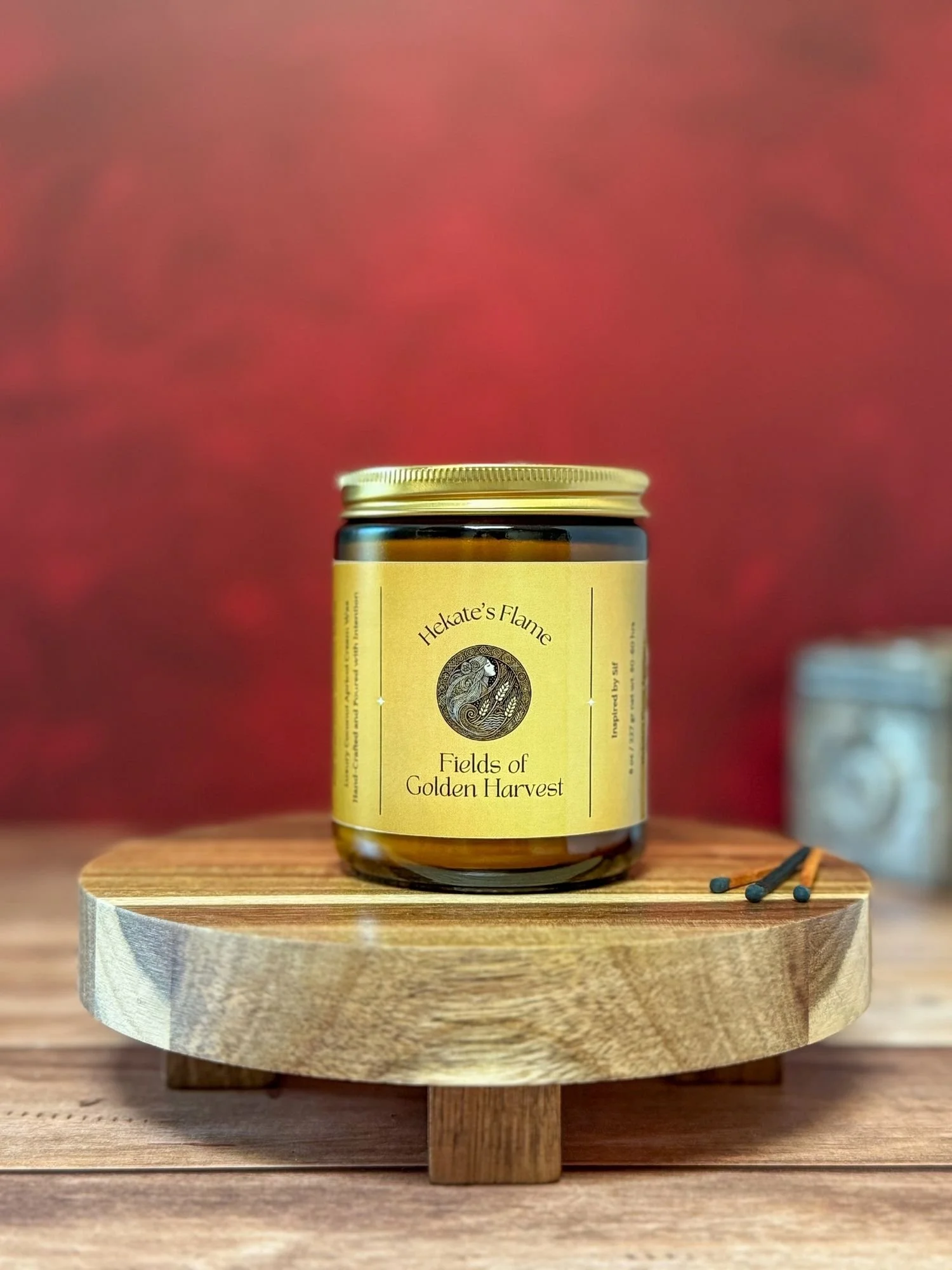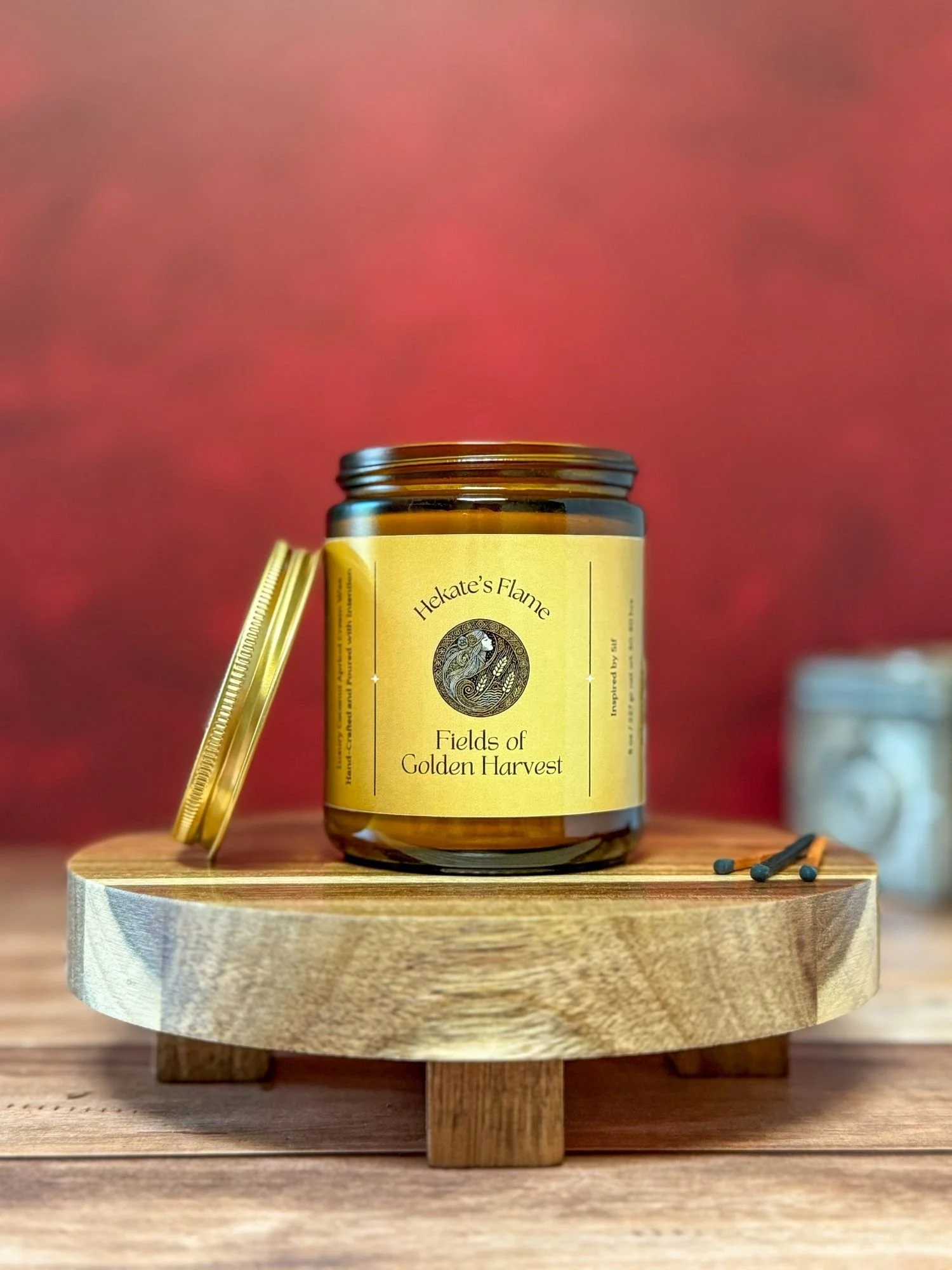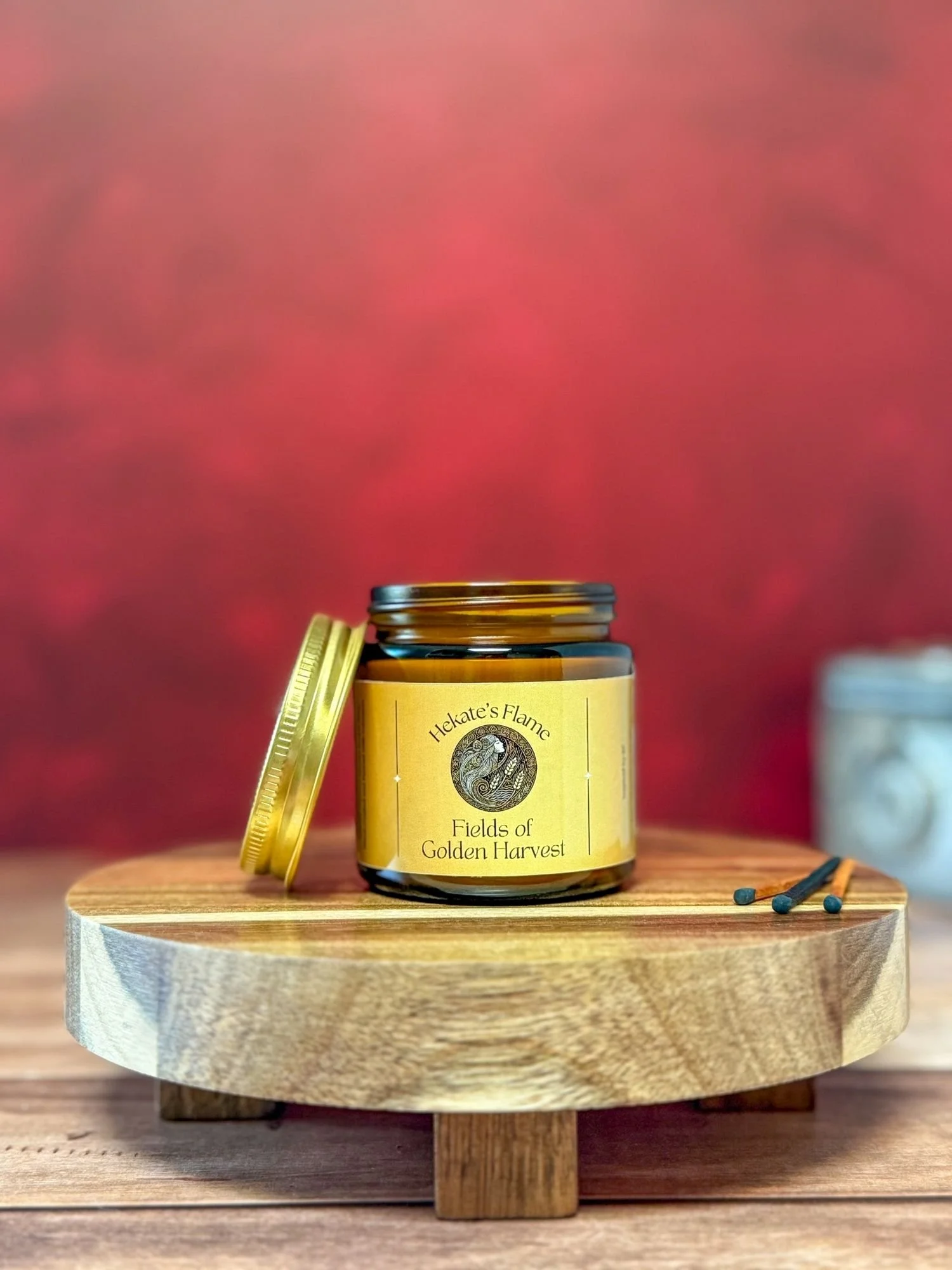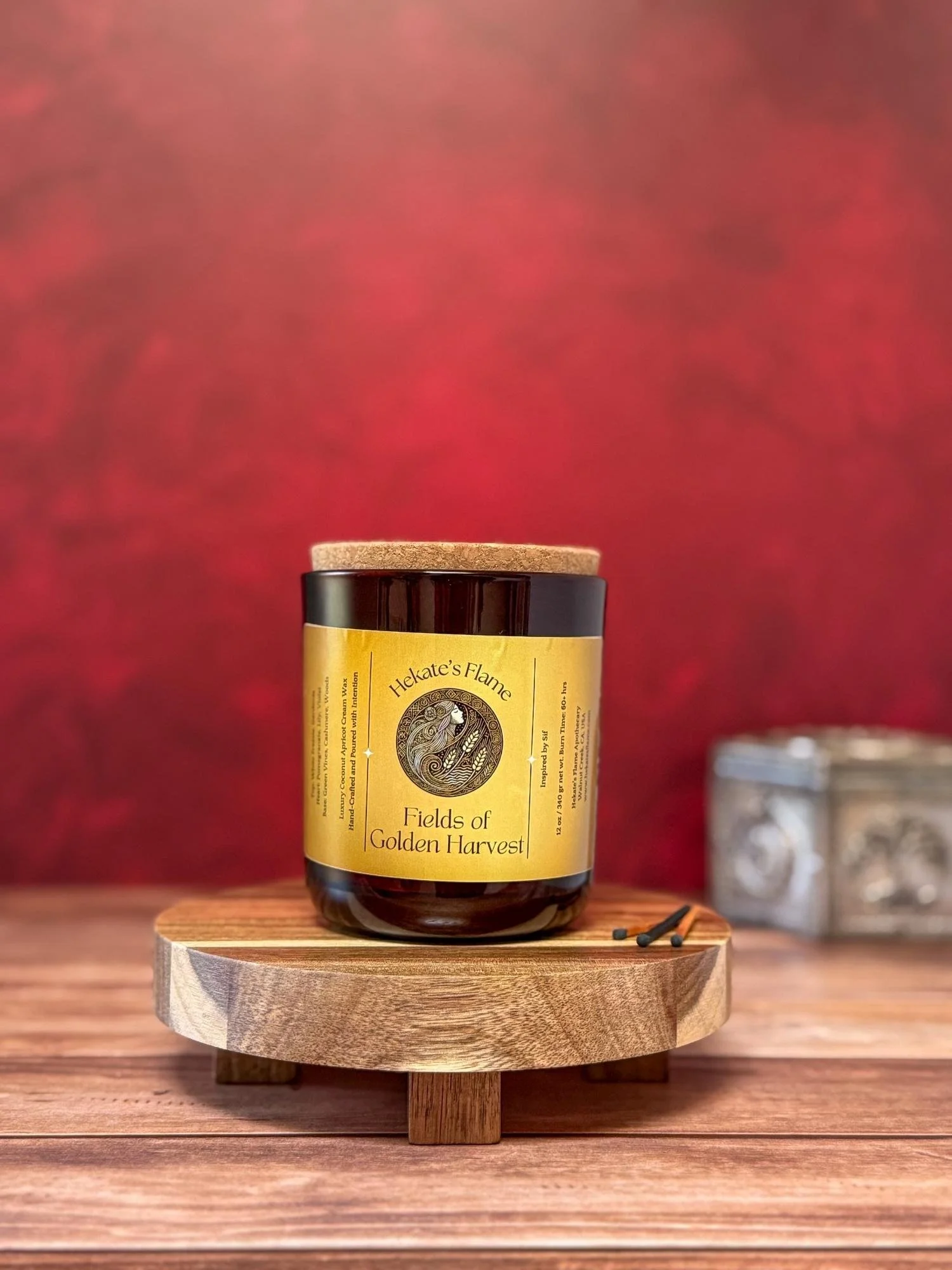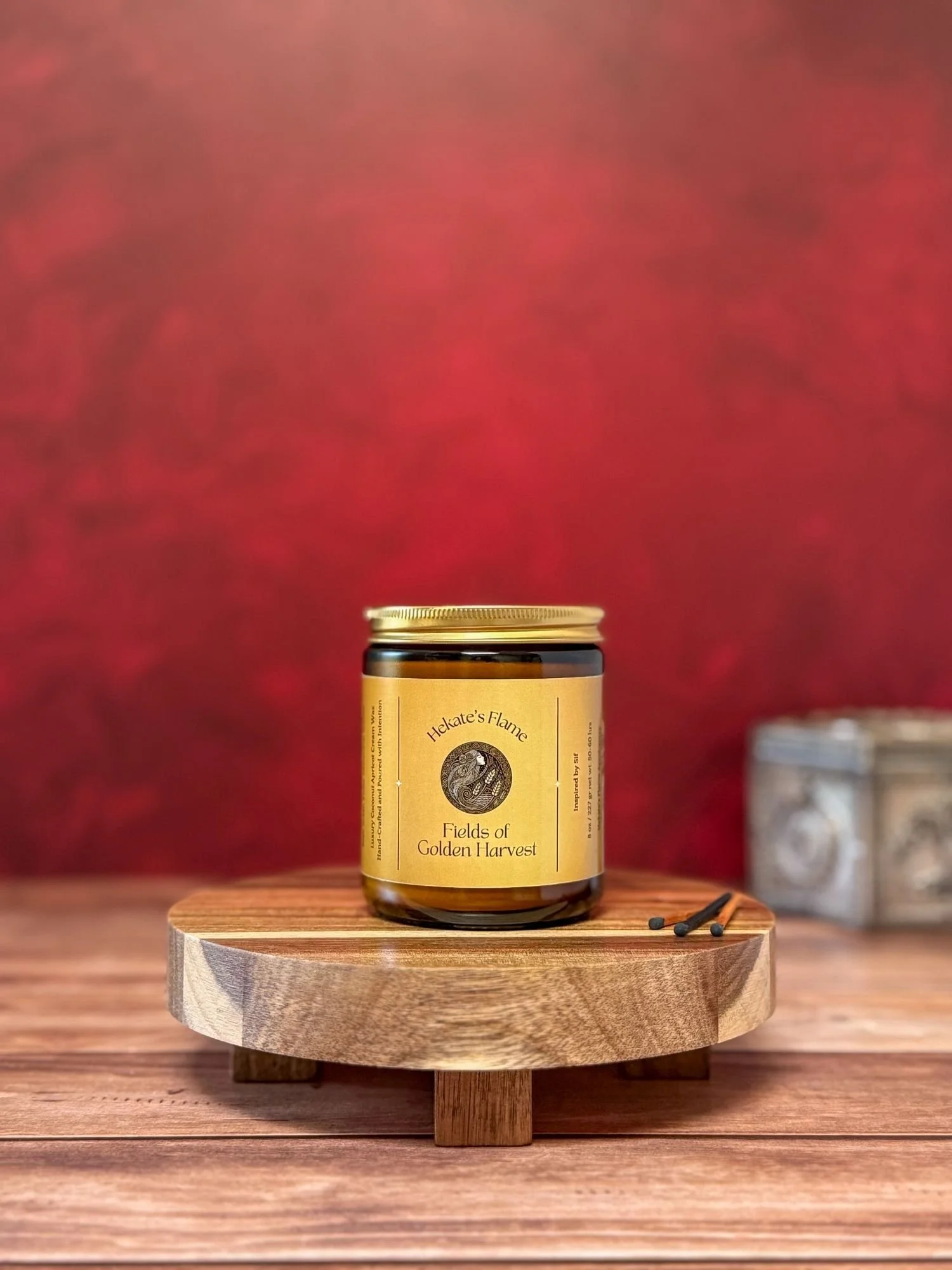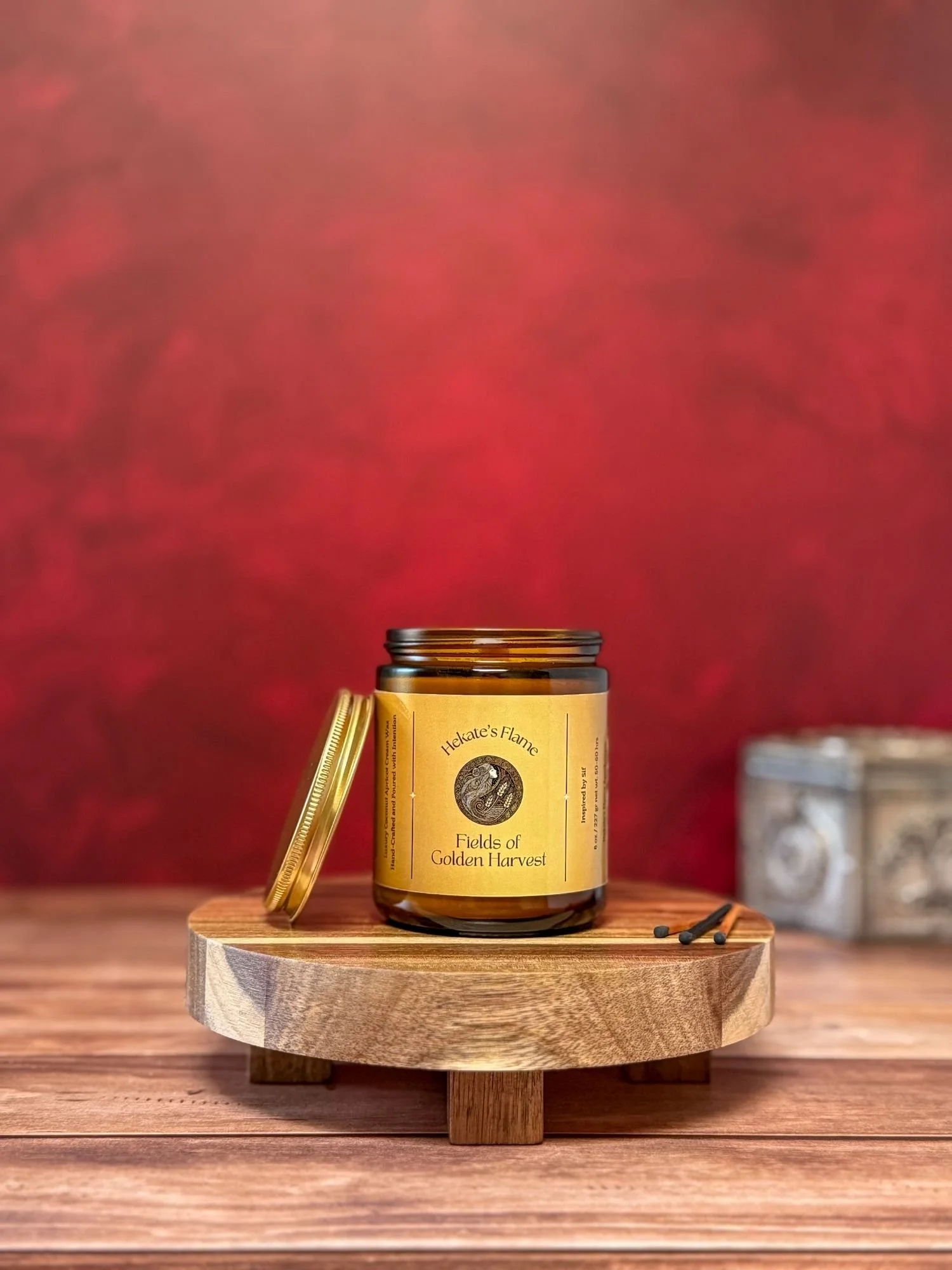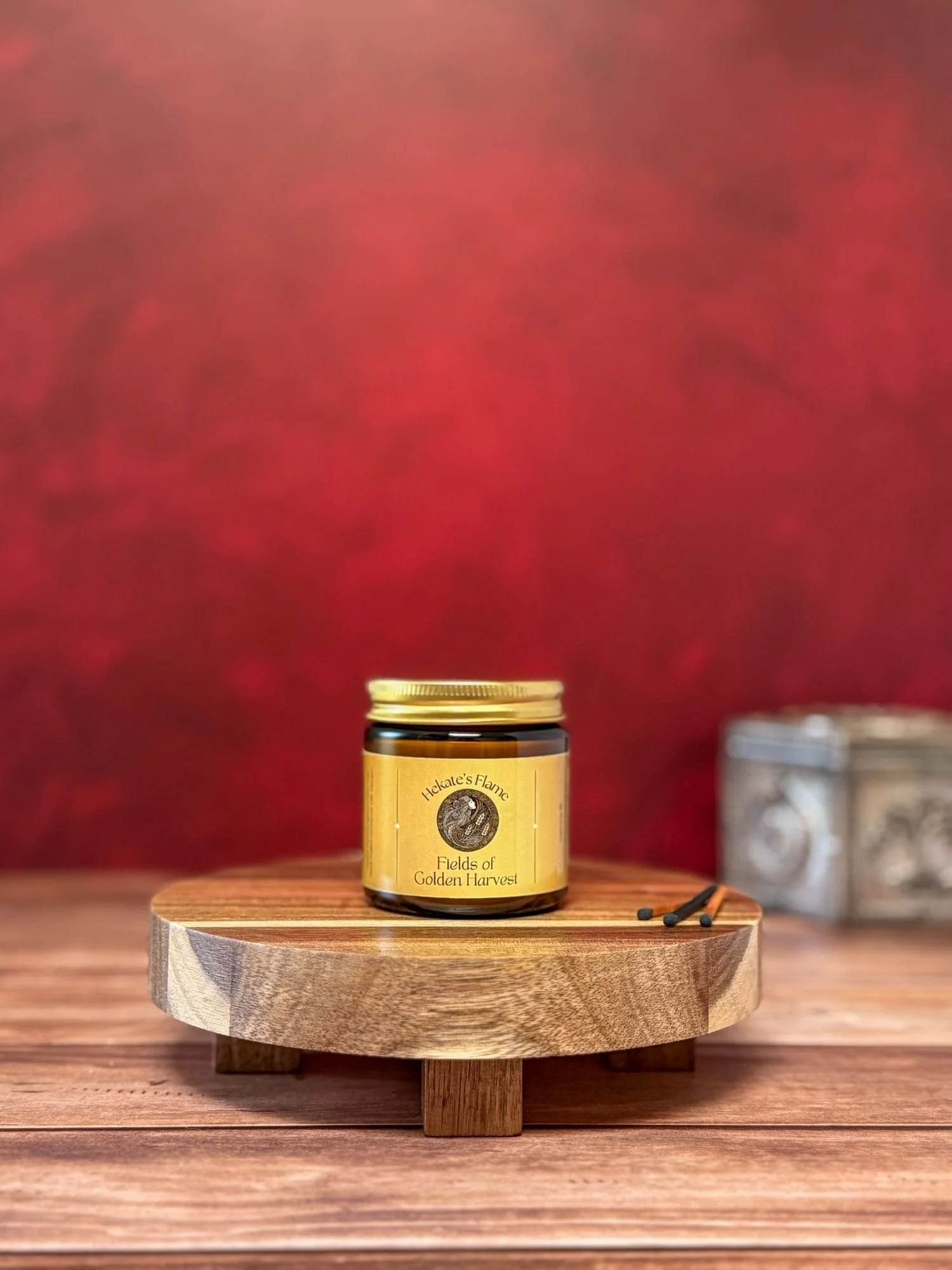‘Allmother’s Blessing’: a handmade artisanal candle inspired by Frigg, the Norse goddess of marriage, motherhood, prophecy, clairvoyance, and fertility
She who weaves the unseen and watches the world from cloud and storm
Imagine the first light of morning spilling across woven cloth. Still, golden, and full of quiet promise. That’s the heart of Allmother’s Blessing: mandarin and lemon bright as dawn, bergamot and ginger warm with calm strength, and a soft trail of jasmine and white tea lingering like the hush after a tender word. A scent of grace and quiet power, for those who hold much, see far, and love without fanfare.
Scent Notes:
Top: Mandarin, Lemon
Heart: Bergamot, Ginger
Base: Jasmine, White Tea
☀️ Season Scent: Summer
🍊 Primary Scent Family: Citrus & Fruity
🌿 Secondary Scent Family: Aromatic & Herbal
Please visit this blog post for more information on Scent Profiles, Top, Heart, and Base Notes.
Our candles are lovingly handcrafted in our home studio, Nimue’s Lair, nestled in Walnut Creek, CA. Each one begins with a luxurious blend of coconut-apricot wax, carefully infused with premium fragrance oils. Poured by hand into elegant glass vessels and amber jars, they’re finished with hand-cut labels and enchanted final touches. Every candle is a small ritual, infused with magick, intention, and the quiet glow of story.
-
12 oz Deluxe – Wine Red Aura Glass · Coco Apricot Wax
Burn Time: 60+ hours
Bold and enduring, this candle fills your space with myth and memory. Crafted for spacious sanctuaries, this candle shines in wide-open living rooms, high-ceilinged studios, and sacred hearths ~ places where scent is free to roam and the flame becomes a luminous companion to stillness and story.8 oz Classic – Amber Jar · Coco Apricot Wax
Burn Time: 50–60 hours
A perfect size for quiet corners and thoughtful pauses. Let it warm your reading nook, home office, or bedside altar, where its flame flickers like a whisper of intention.4 oz Petite – Amber Jar · Coco Apricot Wax
Burn Time: 20–25 hours
Small in size, rich in presence. This candle is ideal for travel, gifting, or sanctifying intimate spaces - guest rooms, personal altars, or quiet corners where scent and flame are invited to linger with intention. -
For detailed information about our waxes, wicks, fragrance blends, and vessels, please see our Ingredients & Materials Guide.
-
For guidance on how to tend your flame with care, ensuring the cleanest, safest, and most enchanting burn, please visit our Candle Care Guide.
-
Please visit the Shipping and Returns Information page for details.
-
All photographs, images, and written content on this website are original works of Hekate's Torch Apothecary, LLC (doing business as Hekate’s Flame Apothecary) and are protected by copyright. They may not be used, altered, shared, or reposted on any platform without explicit written consent. All label designs, photos, images, and content are the exclusive property of Hekate's Torch Apothecary, LLC.
For inquiries regarding the use of our content, please contact: care@hekatesflame.com
© 2025 Hekate's Torch Apothecary, LLC. All rights reserved.
Content Warning:
This post explores ancient myths that include themes of violence, including assault and warfare, which may be sensitive for some readers. Please proceed with care and be mindful of your well-being while engaging with these stories.
Frigg: The Beloved Weaver of Fates and Queen of Asgard
Frigg, the Queen of Asgard and the highest-ranking goddess of the Aesir, is a complex and multifaceted figure in Norse mythology. Known as the goddess of marriage, motherhood, clairvoyance, and fate, she occupies a central yet mysterious role within the pantheon.
Frigg's myths reveal a goddess as powerful as she is vulnerable, embodying the tensions between love and loss, autonomy and duty, foresight and powerlessness. Though her tales are few, they are rich with cosmic symbolism and emotional depth, cementing her as an enduring figure of reverence.
Fensalir: Frigg's Celestial Domain
In all her stories, Frigg is portrayed as a completely independent woman, even seeming to live apart from her husband in her hall, Fensalir, meaning "Hall of the Marshlands." It is a realm as mystifying as the goddess herself. Described as a watery sanctuary, it is a place of liminality, bridging the earthly and the divine.
Its association with water ties Frigg to fertility, transformation, and the life-giving forces of nature, while its marshy nature symbolizes the shifting and uncertain boundaries of fate, a domain Frigg navigates with wisdom and grace. In this hall, Frigg's wisdom and compassion shine, making Fensalir a sanctuary in life and myth.
Frigg's connection to the heavens is also symbolized by her attire. According to myth, she wears a large blue cape representing the sky, a fitting emblem for the queen of Asgard, who bridges the cosmic and earthly realms. This celestial association reinforces her role as a divine mediator, weaving the threads of fate that govern all beings.
Surrounded by a devoted retinue, Frigg reigns over Fensalir as a queen among goddesses. Fulla, her confidante and keeper of secrets, is entrusted with Frigg's most private concerns. Gná, her swift messenger, rides a magical horse capable of crossing dimensions in a flash, carrying out the goddess's will across the Nine Realms. Hlín, her defender, acts on behalf of mortals, shielding them from harm and ensuring their safety. Each of these figures represents an aspect of femininity, secrecy, swiftness, and protection, that complements Frigg's layered role.
Fensalir is a seat of power and a haven for the souls of the happily married in the afterlife. This parallels Freyja's Folkvangr, though the two realms are distinct in tone and purpose. Where Folkvangr is a field of warriors, Fensalir is a tranquil retreat, reinforcing Frigg's association with love, loyalty, and the bonds of marriage.
Indeed, in mythology and modern interpretations, Fensalir symbolizes stability and refuge. It embodies Frigg's character's nurturing, protective aspects, providing solace for mortals and the goddess herself, whose stories often carry the weight of grief and loss.
Though Fensalir's exact location is never detailed, its watery, ethereal nature reflects the mysterious origins of its mistress, whose powers span the tangible and intangible worlds. Historically, the concept of Fensalir may have roots in the Migration Period (400–700 CE), when Germanic tribes venerated divine couples such as Frija and her consort Odr. Frija, a seeress with powers of divination, was believed to foresee the fate of her people and guide their actions through supernatural insight. This archetype of the divine wife likely influenced the development of Frigg in Norse mythology.
Frigg and the Norns: Mistress of Fate and Foresight
Frigg's powers extend far beyond her roles as wife and mother. As a spinner of fate, she is intricately linked to the Norns, the goddesses who weave the threads of destiny. Frigg's spinning wheel (distaff), Friggerock, is said to be reflected in the night sky as the constellation Orion's Belt, symbolizing her cosmic influence over the flow of time and events. Through the magical art of seidr, Frigg can perceive and shape destiny. However, she often chooses to remain silent about what she knows.
Unlike Freyja, whose use of seidr often leans toward assertive action and manipulation of outcomes, Frigg's strength lies in her restraint and foresight. Her calm authority, combined with a deep understanding of fate's intricacies, sets her apart as a figure of stability amidst the chaos of the divine world. Frigg's silence on certain matters, such as her foreknowledge of Baldr's death, highlights a poignant aspect of her character: recognizing when to act and accepting what cannot be changed. This duality of power and limitation adds a profoundly human dimension to her divine role, making her relatable as both wise and vulnerable.
The practice of seidr, which involves divination and the manipulation of fate, places Frigg alongside Freyja as a master of this sacred magic. Both goddesses embody the dualities of creation and destruction, love and loss, mirroring the intricate dance of life itself. Frigg's foresight, however, is not absolute. Her inability to prevent the death of her beloved son Baldr underscores the boundaries of even divine power, presenting her as a tragic yet resilient figure. In her grief, she embodies the maternal strength to continue despite the devastating loss, a characteristic that resonates deeply with human experiences of love and mourning.
Frigg as the Goddess of Love and Marriage
Frigg's association with love and marriage is deeply rooted in her name, derived from the Old Norse verb "fríja," meaning "to love." This linguistic connection underscores her role as a goddess of unions, partnerships, and emotional bonds. Fridays, named in her honor, were considered particularly auspicious for weddings, a testament to her enduring influence over the institution of marriage. Yet, Frigg's marriage to Odin, the Allfather, is anything but a simple ideal. Their relationship is marked by love, rivalry, infidelity, and a surprising balance of power, painting a complex portrait of divine partnership.
Frigg's marital dynamic with Odin reflects her autonomy and wit, qualities that enable her to outmaneuver even the god of wisdom. In Grímnismál from the Poetic Edda, she uses her cunning to expose the shortcomings of Geirröth, Odin's foster son, and win a wager against her husband. This tale is just one example of how Frigg asserts herself in a relationship that defies traditional hierarchies, showcasing her intelligence and strategic mind. However, other accounts complicate this portrayal, casting her in a more ambiguous light ~ perhaps a reflection of Christian influence on the retelling of these myths.
Tales of infidelity further complicate the depiction of their union. In Saxo Grammaticus's Gesta Danorum ("Deeds of the Danes"), Odin departs on a journey, leaving Frigg behind. During his absence, Frigg conspires to topple a statue of Odin adorned with gold.
She enlists the help of a slave, offering herself in return for his assistance in removing and stealing the statue's gold. While the theft succeeds, Odin discovers Frigg's role in the plot upon his return. Ashamed of his wife's actions, Odin imposes exile upon himself, demonstrating his internal struggle with their contentious relationship. However, this account diverges significantly from traditional Norse portrayals of Frigg and reflects the Christian moral framework of Saxo Grammaticus, who sought to reinterpret Norse deities through a lens of sin and punishment.
The Ynglinga Saga, a 13th-century text, provides another account of Frigg's infidelity. During another one of Odin's prolonged absences, his brothers Vili and Vé are left to rule in his stead. Believing Odin is dead or lost forever, the brothers divide his possessions, and Frigg shares her bed with them to maintain the continuity of the ruling lineage. When Odin eventually returns, he uncovers the betrayal, though Frigg's actions are portrayed as pragmatic rather than malicious. Loki later alludes to these circumstances in Lokasenna ("Loki's Taunts") from the Poetic Edda, using them to publicly humiliate Frigg. Freyja, however, rises to her defense, warning Loki to respect the queen of Asgard, whose power and knowledge surpass his understanding.
The Christianization of Scandinavia likely influenced these retellings, emphasizing infidelity as a cautionary tale to uphold Christian ideals of marital fidelity and wifely submission and frame female autonomy as dangerous or suspect. Such narratives may have been exaggerated or selectively preserved to reinforce patriarchal values. For example, Loki's taunts in Lokasenna, where he mocks Frigg for her relationships with Odin's brothers, reveal a cultural shift toward controlling and judging female independence. This contrasts sharply with Odin's own celebrated infidelities, which were framed as demonstrations of his virility and power, underscoring the double standards introduced by these later retellings.
Despite these narratives, Frigg's intelligence, foresight, and maternal strength shine through. Her ability to navigate a complex relationship with Odin highlights the resilience and agency that characterized powerful women in Norse mythology. While Christianized accounts may have sought to diminish her independence, the underlying Norse reverence for her wisdom and cunning endures, offering a window into a culture where women were celebrated for their intellect and adaptability and recognized as autonomous individuals capable of many – if not all – of the same sorts of behavior as men. Moreover, Frigg's marriage is a microcosm of the cultural and religious tensions that shaped the Norse myths we know today. By examining her stories with a critical eye, we can disentangle the original depictions of a powerful, multifaceted goddess from the patriarchal layers imposed by later Christian interpretations.
Indeed, Frigg’s relationship with Odin is not defined solely by submission or devotion but by a dynamic interplay of love, manipulation, and mutual respect. Frigg's actions may seem morally ambiguous by modern standards, yet they align with the Norse cultural value of cunning and independence as a form of power, where women were celebrated for their intelligence and independence.
Frigg's Cleverness: Stories of Witty Manipulation
Frigg and the Lombards: How the Goddess Secured Victory Through Deception
One of the most famous stories of Frigg's cunning comes from the Origo Gentis Langobardorum (The Origin of the Lombards) and its retellings by Paul the Deacon in his 8th-century work History of the Lombards. This tale highlights Frigg's resourcefulness and ability to influence events, even against Odin's intentions.
In this story, the Winnili, a small Scandinavian tribe, faced an ultimatum from the powerful Vandals: submit to their rule and pay tribute or prepare for war. Rather than surrender, the Winnili appealed to Odin for help. Odin, however, favored the Vandals, proclaiming that victory would be granted to the first tribe he saw at dawn.
Frigg, siding with the Winnili, devised a clever plan. She instructed the Winnili women to let their hair down, braid it across their faces like beards, and stand alongside their men at sunrise. When Odin awoke and looked out over the battlefield, he saw the tribe standing together and exclaimed, "Who are these long-beards?" Frigg replied, "Since you have given them a name, you must also give them victory." Bound by his own words, Odin granted the Winnili victory, and they became known as the Lombards (or "long-beards").
This story, preserved in Paul the Deacon's History of the Lombards, showcases Frigg's wit and ability to outmaneuver even Odin, the Allfather, in matters of fate and battle.
Frigg and the Grímnismál: The Wager Over Geirröth’s Hospitality
Another tale of Frigg's cleverness appears in Grímnismál ("The Lay of Grimnir") from the Poetic Edda. In this story, Frigg manipulates Odin to reveal the failings of his foster son, Geirröth, and to prove her own point about human character.
The story begins with two brothers, Geirröth and Agnarr, who are shipwrecked and taken in by a peasant couple. The couple, in reality, are Odin and Frigg in disguise. Odin fosters Geirröth, while Frigg tends to Agnarr. When the brothers return to their kingdom, Geirröth betrays Agnarr by kicking his boat back into the water, ensuring that he alone reaches their homeland. Geirröth takes the throne, while Agnarr is left adrift.
Watching from their celestial throne in Asgard, Odin boasts about Geirröth's success, while Frigg accuses him of being inhospitable and cruel. Confident in his foster son's character, Odin wagers that Geirröth will be a gracious host if he visited. Disguising himself as a traveler named Grimnir, Odin sets out to test Geirröth's hospitality. However, Frigg, determined to expose Geirröth's shortcomings, sends her handmaiden Fulla ahead to warn the king. Fulla tells Geirröth to beware of a wizard who will arrive soon and to identify him by his uncanny ability to pass by even the fiercest dogs unchallenged.
When Odin arrives at Geirröth's hall, the dogs refuse to attack him, marking him as the wizard of Fulla's warning. Geirröth, suspicious, orders Odin's arrest. He has him bound and tortured by placing him between two roaring fires for eight nights. On the ninth night, Geirröth's son, also named Agnarr after his uncle, takes pity on the silent traveler and offers him a horn of ale. Touched by the boy's kindness, Odin reveals his true identity, praises Agnarr's compassion, and foretells his future ascension to the throne.
Realizing his grave error, Geirröth rushes to free Odin but stumbles and impales himself on his sword, fulfilling Frigg's accusation of his cruelty. With Geirröth dead, the younger Agnarr takes his place as king. This tale illustrates Frigg's sharp mind and ability to manipulate events to expose character flaws. Even when pitted against Odin, the god of wisdom, Frigg demonstrates her strategic brilliance and commitment to justice.
The Tragic Tale of Baldr: Frigg's Eternal Grief
The death of Baldr, the shining god of wisdom and beauty, is one of the most poignant stories in Norse mythology and a defining moment in Frigg's narrative. This tale is steeped in themes of love, foresight, and the limits of power, reflecting the goddess's boundless devotion to her son and her enduring sorrow.
Frigg's anguish began with dreams, visions that both she and Baldr shared, forewarning a tragedy neither could fully comprehend. Despite her gift of knowing all fates, Frigg could not discern the precise nature of this impending doom. In desperation, Odin traveled to the realm of Hel and summoned the spirit of a seeress to uncover the truth. The witch revealed that Hel's halls were being prepared for Baldr's arrival, confirming Frigg's worst fears.
Determined to protect her son, Frigg journeyed across the Nine Realms, imploring all things, animate and inanimate, to swear never to harm Baldr. Stones, trees, metals, animals, and even diseases pledged their loyalty, rendering Baldr invincible. The gods of Asgard, delighted by this newfound immunity, turned it into a sport, hurling weapons and objects at Baldr to watch them bounce harmlessly off his radiant form. It was a game born of confidence in Frigg's maternal love and foresight.
However, Loki, ever the trickster, sought to exploit a single oversight. Disguised as an old woman, he visited Frigg in her hall of Fensalir and inquired about the gods' peculiar sport. Unaware of his true identity, Frigg explained the measures she had taken to protect Baldr but admitted that she had overlooked the mistletoe. The young plant, she reasoned, was too small and harmless to pose any real threat.
Seizing this opportunity, Loki ventured west of Valhalla to retrieve a sprig of mistletoe. Crafting it into a sharp projectile, he returned to Asgard. He approached Hodr, Baldr's blind brother, who sat apart from the games, unable to participate. Loki offered to guide Hodr's aim, enabling him to join the fun. Unbeknownst to Hodr, the mistletoe dart was deadly. As it flew through the air, it pierced Baldr's heart, killing him instantly.
A horrified silence fell over Asgard as the gods wept for their fallen kin. Frigg, stricken with grief, begged for someone to journey to Hel and plead for Baldr's return. Hermod, the swift messenger god, and Baldr's half-brother, volunteered for the perilous task. Riding Sleipnir, Odin's eight-legged horse, Hermod descended into the misty realm of Niflheim. There, he found Baldr seated in a place of honor beside Hel herself, his wife Nanna having joined him after succumbing to heartbreak.
Hel agreed to release Baldr and Nanna under one condition: all beings, living and dead, must weep for him. Hermod returned this message to Asgard, and the gods sent emissaries across the cosmos. Tears flowed from every creature, animate and inanimate, as the Nine Realms mourned the loss of Baldr. Yet their efforts were thwarted by a lone giantess named Thokk, who refused to shed a single tear, proclaiming, "Let Hel hold what she has." Thokk was revealed to be Loki in disguise, ensuring that Baldr would remain in the underworld.
Frigg's grief was immeasurable. She had gone to extraordinary lengths to protect her son, yet fate and trickery had conspired against her. Baldr's death marked a turning point for the gods, a prelude to the cataclysmic events of Ragnarök. For Frigg, it was an eternal wound, her sorrow resonating across the cosmos as a symbol of maternal love and the inevitability of loss.
This story is not merely a tale of tragedy; it reflects the universal human experience of grief. Frigg's sorrow is divine and profoundly relatable, portraying her as a mother whose love transcends even the boundaries of life and death. Her lament echoes through the ages, a reminder of the fragility of even the most radiant beings.
Frigg and Freyja: Twin Goddesses of Love and Fate
The relationship between Frigg and Freyja is one of the most compelling and debated aspects of Norse mythology. Both goddesses occupy central roles in their respective pantheons, Frigg among the Aesir and Freyja among the Vanir, and their overlapping attributes suggest a shared origin in an earlier Germanic deity, often identified as Frija. Scholars theorize that Frija, a seeress and goddess of fertility, was reimagined into two distinct figures by the Norse as their mythology evolved.
Frigg, tied to the Aesir, embodies cosmic order, wisdom, and familial bonds, while Freyja, associated with the Vanir, represents passion, beauty, and prosperity. This distinction mirrors the characteristics of their pantheons: the Aesir as gods of war and societal structure, and the Vanir as gods of nature and fertility. Despite these differences, the two goddesses share striking similarities. Both are linked to the magical practice of seidr, which involves weaving fate and shaping the future. Both possess magical cloaks of falcon feathers that allow them to transform into birds, and both are associated with fertility and love.
One notable divergence is their respective realms. Frigg presides over Fensalir, a watery hall shrouded in mystery and associated with the afterlife of happily married couples. Freyja, in contrast, rules over Folkvangr, a field of the slain that parallels Odin's Valhalla.
Folkvangr is said to mirror Vanaheim, the beautiful homeland of the Vanir. While Fensalir's location is never explicitly stated, its enigmatic nature reinforces Frigg's connection to hidden wisdom and the liminal spaces between life and death.
Speculation about Frigg and Freyja's connection is further complicated by the oral traditions of Norse mythology, which were only recorded during the Christian era.
Without primary sources from the pagan period, it is impossible to determine whether the goddesses developed independently or diverged from a single archetype. Some scholars propose that Freyja's prominence in surviving myths reflects her enduring popularity, while Frigg's quieter, more elusive character is a remnant of her association with earlier Germanic traditions.
Despite these uncertainties, the interplay between Frigg and Freyja highlights the fluidity of Norse mythology, where deities often embody multiple, sometimes contradictory, aspects of existence. Their stories reflect the complexities of human experience, encompassing love, power, and the tension between order and chaos.
Modern Neo-Pagan and Wiccan movements have shaped distinct roles for Frigg and Freyja, offering new perspectives on their significance. While Freyja is celebrated for her bold sensuality, warrior spirit, and connection to raw, untamed nature, Frigg is revered for her steady wisdom, maternal strength, and ability to navigate the intricacies of fate with calm authority. These differing interpretations allow us to engage with the goddesses in ways that resonate with their individual experiences, highlighting the enduring relevance of their myths in contemporary spiritual practices.
While patriarchal interpretations of mythology often seek to diminish the roles of female figures, the Norse myths frequently depict neither Frigg nor Freyja as secondary to their male counterparts. Both goddesses are fully realized figures embodying autonomy and power within their respective realms. This balance has allowed their stories to remain potent symbols of feminine strength and versatility, even in the face of later cultural reinterpretations that may have sought to frame their actions through a more patriarchal lens.
Frigg Across Cultures: Archetypal Parallels and Her Evolution Through Christianity
Frigg's myths bear remarkable similarities to tales from other cultures, suggesting a shared archetypal origin. Her grief over Baldr's death echoes the mourning of Cybele for her son Attis in Mediterranean mythology, while her association with spinning links her to figures such as the Moirai of Greek mythology and the Fates of Roman tradition.
In later folklore, Frigg survives as Frau Holle, a Germanic goddess of domesticity and winter, who rewards industriousness and punishes laziness. This transformation into a household deity reflects the changing cultural landscape as Norse paganism gave way to Christianity. Frigg's once-multifaceted role as a maternal, protective, and authoritative figure was distilled into the domestic sphere, aligning with emerging societal ideals of femininity emphasizing obedience and industriousness.
As Christianity spread, aspects of Frigg's character were syncretized with the veneration of the Virgin Mary, who became the prevailing symbol of feminine virtue. Unlike Frigg, who wielded foresight, authority, and independence as an equal to Odin, the Virgin Mary's image centered on submission, humility, and dutiful devotion. This shift marked a significant cultural reimagining of female divinity, moving from the empowered, multifaceted archetype of Frigg to the more constrained and patriarchally aligned figure of Mary.
Frigg's Enduring Legacy: The Weaver of Life's Tapestry
Frigg's story is one of profound love and quiet strength. As a mother, wife, and goddess, she embodies joy and sorrow, power and vulnerability. Her myths remind us of the interconnectedness of all things, the inevitability of change, and the resilience of the human spirit.
Through her spinning wheel, Frigg weaves the threads of fate, crafting a tapestry that reflects the beauty and fragility of existence. In honoring Frigg, we celebrate a goddess and the timeless truths of life, love, and destiny. Her enduring appeal lies in her ability to embody the joys and sorrows that define the human condition.
As a weaver of fate and a goddess who understands the limits of even divine power, Frigg resonates deeply with the human experience of striving for control in an unpredictable world. Her survival into modern Neo-Paganism as a symbol of love, wisdom, and strength underscores her timeless relevance, inviting us to find inspiration in her stories and see our struggles as part of life's intricate design.
References:
Cavendish, R. (1970). Man, myth and magic: an illustrated encyclopedia of the supernatural. Marshall Cavendish Corporation.
Illes, J. (2010). Encyclopedia of spirits: The ultimate guide to the magic of fairies, genies, demons, ghosts, gods & goddesses. Harper Collins.
Littleton, C. S. (2002). Mythology: the illustrated anthology of world myth & storytelling. Duncan Baird.
Mark, J. J. (2021, August 27). Frigg. World History Encyclopedia. https://www.worldhistory.org/Frigg/
McCoy, D. (n.d.). Frigg. Norse Mythology for Smart People. https://norse-mythology.org/gods-and-creatures/the-aesir-gods-and-goddesses/frigg/
McCoy, D. (2016). The Viking spirit: An introduction to Norse mythology and religion. CreateSpace Independent Publishing Platform.
"Frigg is the foremost. She owns the dwelling called Fensalir, and it is splendid in all ways."








































